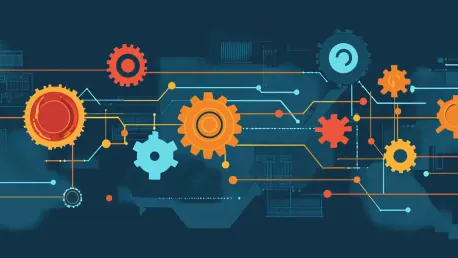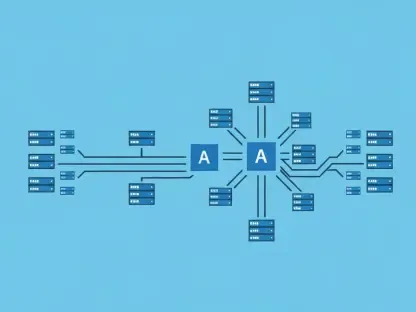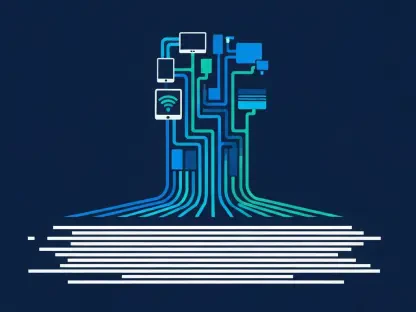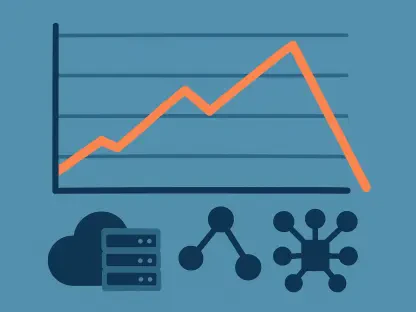DevOps, initially conceived about fifteen years ago, emerged as a methodology to bridge the divide between software development and operations, thus accelerating software deployment. At the DevOpsCon New York conference, it was apparent that DevOps has evolved to face new challenges that extend its foundational principles. The discussions honed in on introducing DevSecOps, improving resilience and safety procedures, faster incident resolution, leveraging AI assistants, and realigning organizational structures to optimize DevOps implementation. A persistent theme at the conference was that DevOps is catalyzing a culture shift alongside technological transformation. The changes necessitate a closer interaction between operations and development staff, fundamentally altering how these teams collaborate. This cultural evolution is further influenced by new trends in DevOps that aim to impact IT culture significantly.
The Rise of DevSecOps
Integrating Security from the Start
Jonathan Singer from Checkmarx posited that the future of DevOps lies in DevSecOps, with an emphasis on security. He maintained that high-performing code necessitates secure code, and application security ought to be integral from the first line of code through to cloud deployment. Checkmarx enables preemptive application security, positioning it as a critical aspect of the development lifecycle. He suggested that security responsibilities be integrated within development teams, with tools aiding in prioritizing and triaging code vulnerabilities to manage the vast number of potential threats efficiently. As security is now a cornerstone rather than an afterthought, its integration ensures that vulnerabilities are managed promptly, reducing the risks of exploited weaknesses in the system.
Furthermore, the shift towards DevSecOps marks a significant evolution in how developers perceive and handle security. Instead of treating it as an external concern managed by a separate department, developers are increasingly owning the security aspect, embedding it within their development processes. This integration is not only about tools but also about mindset and culture. Development teams are now equipped with advanced training and resources that empower them to proactively identify and mitigate security threats. This holistic approach ensures a robust security posture, reducing the likelihood of breaches and fostering a culture of shared responsibility.
Tools and Practices for Secure Development
The integration of security into the DevOps pipeline involves using advanced tools and practices. Automated testing tools like Eggplant’s Digital Automation Intelligence (DAI) continuously test and refine applications. When a UI anomaly is detected during pipeline testing, the DAI capability identifies it based on past behavior and automatically generates a ticket with relevant notes and screenshots. This enables developers to fix issues and restart the pipeline, illustrating the continuous nature of improvements in the development lifecycle. Such tools not only streamline the development process but also ensure that security is not compromised at any stage, reflecting a mature and holistic approach to software development.
Moreover, the practices surrounding secure development have evolved to include regular code reviews, penetration testing, and vulnerability assessments. By incorporating these practices into the DevOps pipeline, organizations can identify and address potential security issues early in the development process. This proactive approach minimizes the risk of security breaches and ensures that the final product is not only functional but also secure. Additionally, the use of machine learning and artificial intelligence in security tools enhances their ability to predict and respond to threats, providing an added layer of protection in the DevOps environment.
Enhancing Resilience in DevOps
Addressing Risks in Design and Use
Jabe Bloom’s keynote on resilience emphasized the importance of addressing both risks in design and risks in use. Risks in design are those anticipated during planning, while risks in use involve unexpected incidents in production. Bloom stressed reducing cognitive loads on individuals responding to system strains or failures and designing systems to recover swiftly from adverse events. Resilience hinges on human interaction, even in technologically advanced processes like CI/CD pipelines. The objective is to configure technology to mitigate cognitive burdens on humans while maintaining robust, resilient systems. This approach ensures that even in the face of unforeseen challenges, systems can maintain operational continuity, reflecting a comprehensive resilience strategy.
Bloom’s perspective on resilience underscores the necessity of anticipating both known and unknown risks. By incorporating resilience into the design phase, organizations can build systems that are better prepared to handle unexpected events. This involves creating redundant systems, implementing failover mechanisms, and designing with the assumption that failures will occur. Such proactive measures ensure that when issues arise, they can be quickly addressed without significant disruption to service. Additionally, the focus on human interaction highlights the importance of training and empowering teams to respond effectively to incidents, further enhancing the overall resilience of the organization.
Building Trust and Reducing Cognitive Load
Building trust within teams and reducing cognitive load are crucial for resilience. This involves creating systems that can recover quickly from failures and ensuring that team members are not overwhelmed by the complexity of the systems they manage. By focusing on human factors and designing systems that support quick recovery, organizations can enhance their overall resilience. Trust is built through transparent communication, collaborative problem-solving, and shared responsibilities. When team members feel supported and confident in their roles, they are better equipped to handle the stresses associated with system failures, leading to a more resilient organization.
Furthermore, reducing cognitive load involves simplifying processes and providing clear, actionable information to team members. This can be achieved through the use of automated incident response tools, intuitive dashboards, and comprehensive training programs. By minimizing the mental effort required to manage complex systems, organizations can improve the efficiency and effectiveness of their teams. This not only enhances resilience but also contributes to a more positive work environment, where team members feel empowered and capable of handling challenges. Overall, the combination of trust-building and cognitive load reduction creates a robust foundation for resilience in the DevOps context.
Leveraging AI for DevOps
AI Assistants for Developer Productivity
Keynote speakers at the event explored various aspects of advancing DevOps practices, including leveraging AI initiatives for enhancing developer productivity. AI assistants can help in automating repetitive tasks, identifying potential issues before they become critical, and providing insights that can help developers make better decisions. This not only speeds up the development process but also improves the quality of the software being developed. By reducing the manual effort required for routine tasks, AI frees up developers to focus on more complex and creative aspects of their work, leading to higher productivity and innovation.
The application of AI in DevOps goes beyond basic automation. Advanced AI algorithms can analyze vast amounts of data, identifying patterns and anomalies that might elude human observation. This capability allows AI to provide predictive insights, enabling developers to proactively address potential issues before they escalate. Additionally, AI can facilitate more informed decision-making by processing data from various sources and offering recommendations based on historical trends and real-time analysis. By leveraging AI, organizations can enhance the accuracy, efficiency, and effectiveness of their DevOps processes, ultimately delivering better software faster.
AI in Incident Resolution and Observability
AI can also play a significant role in incident resolution and observability. By analyzing large volumes of data, AI can help identify patterns and anomalies that might indicate potential issues. This allows teams to address problems before they impact users, improving the overall reliability and performance of their systems. Enhanced observability tools, supported by AI, provide deeper insights into system behavior, enabling faster and more effective incident resolution. With AI-driven observability, teams can monitor complex systems in real-time, gaining a comprehensive understanding of their state and performance.
Moreover, AI can assist in incident resolution by offering automated responses to detected issues. For example, if an anomaly is detected in system performance, AI can trigger predefined actions to mitigate the problem, such as reallocating resources or adjusting configurations. This rapid response capability minimizes downtime and ensures that systems remain operational despite underlying issues. Additionally, AI can provide detailed post-incident analysis, helping teams understand the root cause of problems and implement measures to prevent recurrence. This continuous learning process enhances the overall resilience and reliability of systems, making AI an invaluable asset in the DevOps toolkit.
Organizational Transformation for DevOps Success
Overcoming Institutional Silos
John Willis focused on the necessity for organizational transformation to embed true cyber resilience. This involves overcoming the risks of technical debt, shadow IT, and shadow AI by dismantling institutional silos and aligning business, IT, and cybersecurity responsibilities. Willis drew from W. Edwards Deming’s system of profound knowledge, underscoring its relevance to contemporary and future work paradigms. Successful DevOps transformation hinges on appropriate organizational structuring and fostering an environment of continuous improvement. By eliminating silos and promoting cross-functional collaboration, organizations can better align their efforts and achieve more cohesive and effective results.
Institutional silos often hamper the flow of information and impede collaborative efforts. To address this, organizations must create an environment where cross-functional teams can work seamlessly together towards common goals. This involves redefining roles, responsibilities, and processes to foster greater integration and collaboration. By breaking down silos, organizations can ensure that all stakeholders are aligned and working in concert, minimizing misunderstandings and enhancing overall efficiency. Additionally, continuous improvement should be ingrained in the organizational culture, encouraging teams to continually evaluate and refine their practices to achieve better outcomes.
Aligning Business, IT, and Cybersecurity
Aligning business, IT, and cybersecurity responsibilities is crucial for the success of DevOps. This involves creating a culture of collaboration and continuous improvement, where all teams work together towards common goals. By breaking down silos and fostering a collaborative environment, organizations can ensure that their DevOps initiatives are successful and sustainable. This alignment requires a shared understanding of objectives, priorities, and challenges, enabling teams to coordinate their efforts effectively and deliver value to the organization.
A key aspect of this alignment is establishing clear lines of communication and accountability. Business, IT, and cybersecurity teams must have regular touchpoints to discuss progress, share insights, and address any issues that arise. This collaborative approach ensures that all perspectives are considered and that solutions are comprehensive and well-informed. Additionally, aligning these functions helps to ensure that security considerations are integrated into every aspect of the development process. By embedding security within the broader context of business and IT priorities, organizations can create a more resilient and secure DevOps environment.
Continuous Improvement and Automation
Enhancing Automated Testing and CI/CD Pipelines
Exhibitors at the conference emphasized the importance of properly executing DevOps, which includes enhancing automated testing, better observability, and CI/CD pipeline technology advancements. Automated testing tools and CI/CD pipelines are essential for ensuring that code is continuously tested and deployed, reducing the risk of errors and improving the overall quality of the software. These tools enable developers to quickly identify and address issues, ensuring that software is always in a deployable state. By automating repetitive tasks, these technologies also free up developers to focus on more complex and value-added activities.
The evolution of automated testing and CI/CD pipelines has made it possible for organizations to adopt practices like continuous integration and continuous delivery. Continuous integration involves frequently merging code changes into a shared repository, followed by automated builds and tests. This practice ensures that code changes are regularly tested, reducing the likelihood of integration issues. Continuous delivery takes this a step further, automating the deployment process so that new code can be released to production environments more quickly and reliably. Together, these practices enhance the agility and responsiveness of development teams, enabling them to deliver high-quality software at a faster pace.









